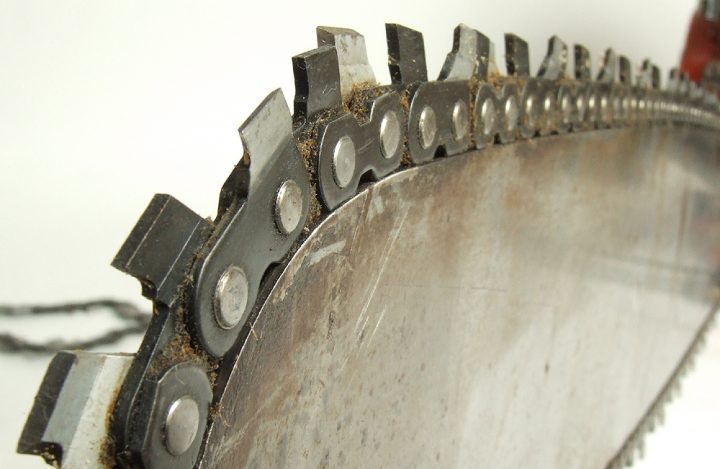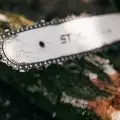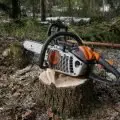Chainsaws are invaluable for harvesting firewood, but like all tools, they sometimes need new parts. Find out how to measure a chainsaw bar and chain to get the correct replacements.
If you need to buy a new chainsaw bar or chain, it’s important to find the perfect fit. Here’s a guide on how to measure the size of your chainsaw bar and chain.
Table of Contents
- Why Do You Need to Measure Chainsaw Bar?
- Safety Tips
- How to Measure a Chainsaw Bar
- How to Measure a Chainsaw Chain
- Chainsaw Sizing Guide
- FAQs (Frequently Asked Questions)

Why Do You Need to Measure Chainsaw Bar?
Chainsaws are versatile tools, great for light pruning, cutting up firewood, and much more. An essential tool in the professional- and DIY-forestry worlds, the chainsaw is a powerhouse—when it’s running as it should. However, over time, and with repeated use, a chainsaw chain can wear out, and a chainsaw bar can become bent or damaged, leading to the chainsaw not cutting straight.
Overlooking something as simple as keeping the saw’s oil reservoir filled may permanently damage the chainsaw bar and chain. Replacing both items is very simple, and so is figuring out the correct replacement sizes when you know how to.
So, yes, with all that use, you will eventually need to replace your chainsaw bar or chain. But before you are able to buy either, it’s important to know the exact size of each. And to know the exact size you will need to know how to correctly measure the chainsaw bar and chain.
Using the wrong size bar or chain can damage the chainsaw and injure the chainsaw operator. It’s not hard to learn how to measure a chainsaw bar or how to measure a chainsaw chain and will save time at the hardware store.
Safety Tips
Before anything, safety comes first! You should disconnect the chainsaw from its power source before following the procedures presented in this article. If the chainsaw is powered by a lithium-ion battery then you should remove the battery. If it’s a corded chainsaw, simply unplug the tool from its power source.
It’s may also not a bad idea to wear some protective gloves because the chainsaw blade links on a chainsaw chain are sharp and can easily scratch or cut skin.
How to Measure a Chainsaw Bar
Chainsaws are typically sold by chainsaw bar lengths, so most of the time the tool’s owner will know the bar size when purchasing a replacement bar. However, chainsaw bar length can be forgotten, or the tool may have a different original owner so the current owner doesn’t know the chainsaw bar length.
You can measure a chainsaw bar in two ways different ways. The most common is the effective cutting length. That’s simply put as the distance from the tip of the bar to the front of the chainsaw body, where the bar disappears into the saw.
To measure a chainsaw’s effective cutting length (or simply, “length”):
- Place a tape measure at the very tip of the bar.
- Measure straight back to the point where the bar enters the chainsaw body.
- Round that measurement up to the nearest even number.
Because chainsaws are only sold in even numbers, you will need to round up odd numbers and fractions to the nearest even number. A saw with a 15-inch effective cutting length is a 16-inch chainsaw. If you measure 18-3/4-in., it’ll be a 20-inch chainsaw.
The other method on how to measure a chainsaw bar is also simple, but this time requires disassembling the chainsaw. Here’s how:
- Use a scrench to loosen the bolts that hold the protective case in place.
- Remove the chainsaw bar and chain.
- Measure the bar from the tip to the center slot—and round up, if necessary.
For the first step, on the side of the chainsaw are one, two, or three bolts, this depends on the make and model of the saw. The bolts here are to secure a protective case over the point where the bar, chain, and sprocket are attached.
A chainsaw scrench (which is a combination wrench and screwdriver) is specifically designed for this job. Use the socket wrench end to first loosen and remove the nut, or nuts, by twisting counterclockwise. Once the nuts are off, the case will be able to slip right off. It’s important to make sure you place the bolts somewhere safe so that they won’t get lost as you will need them for reassembly.
Step 2, once the case is off, the chain goes slack and it will be a simple task to lift it up and off the bar and the sprocket. After that, you can pull the bar outward from the chainsaw to remove it. Both the chain and the bar should come off very easily if these steps are followed.
Finally, lay the chainsaw bar flat on a table or counter and measure from the rounded end to the center slot at the other end of the bar. As already mentioned, chainsaw bars sell in even numbers, such as 12-inch, 14-inch, and 16-inch bars.
However, this time it is important to not round the measurement up to the nearest even number. The true chainsaw bar lengths are a precise measurement. So, whatever you measure using this method should already be the exact chainsaw bar length you need.
How to Measure a Chainsaw Chain
Learning how to measure chainsaw chain size can be a little trickier, but certainly not difficult. In order to get the correct replacement chain, users will need to obtain three numbers; the pitch, the gauge, and the number of links in the chain.
The good thing with these numbers is that this information may be printed on the majority of chainsaw bars. It doesn’t hurt manufacturers to write or engrave the numbers on the chain saw bar, near the saw’s body. They reflect the chain pitch, the number of driver links, and the chain-link gauge.
If you need these numbers and can’t locate them, or if they’ve worn off, you can measure each of these components to determine the chainsaw chain size.
How to Measure the Drive Links on the Chain
Chainsaw chain sizes heavily depend on the number of drive links on the chain. This is the one step that can become tedious compared to the others, but it’s not complicated. If the bar doesn’t have the information printed on it, you will need to count the drive links.
While not essential, but I would recommend just in case, you can tie a string between links and start the counting right after the string. This will undoubtedly make it easier and less tedious to count the links without losing your start place. All you have to do is make a note of the total number.
How to Measure the Pitch
Drive links are held in place by rivets that are able to keep them securely attached, while also serving as flexible points that allow the chain to bend as it travels around the chainsaw bar. To obtain a number for the chain’s pitch, you must first measure the distance between three rivets, starting at the center of one rivet, passing the second, and ending at the center of the third.
This measurement must be precise, so rather than starting at the end of a tape measure, which has a hook that floats, start at the 1-inch increment on the tape measure for greater accuracy. Let’s say you measure the exact distance between the rivets as 6/8 of an inch. You must now divide it by 2, which gives a result of 3/8 of an inch.
So, the chain’s pitch is 3/8-inch. Common chain pitches include 1/4-inches, .325-inches, 3/8-inches, and .404-inches.
How to Measure the Chain Gauge
The gauge on a chainsaw chain is the thickness of the tips of the links that travel within the groove of the chainsaw bar. The simplest way to figure out the chain’s gauge is to use coins to determine the width of the groove on the bar.
If you’re buying a brand new chainsaw bar, it may be important to also know the gauge of the bar groove. Here’s how to measure a chain saw bar groove:
- Gather a penny, dime, and quarter.
- Insert the coins into the bar groove one at a time.
- Determine which coin best fits into the groove.
Well, for close approximations, you can use a quarter for .063 inches, a dime for .058 inches, and a penny for .043 inches. Alternatively, you could purchase a measuring tool like this:
- Measures the chain pitch, Bar groove width, chain gauge and file size.
Prices pulled from the Amazon Product Advertising API on:
Product prices and availability are accurate as of the date/time indicated and are subject to change. Any price and availability information displayed on [relevant Amazon Site(s), as applicable] at the time of purchase will apply to the purchase of this product.
This tool will not only help you measure bar groove width but also chain pitch, chain gauge, and file size.
Chainsaw Sizing Guide
Having the correct size chainsaw for the job will make your cutting tasks not only easier but also safer. Sizes often vary depending on the type of chainsaw, as each is good for different jobs. Given that there are so many different chainsaw brands, it’s no surprise we have so many different sizes.
The most common chainsaw bar sizes generally range from 12 to 20 inches, but they can also come in sizes as large as 72 inches, typically for professionals. Of course, the longer the bar, the heavier the chainsaw will be. Let’s not forget chainsaw chain sizes, which we’ve written a more detailed article on!
When choosing the right chainsaw size for a specific job, a good rule of thumb is to have a chainsaw bar at least two inches longer than the thickness of the item that you’re cutting.
Certain chainsaw sizes are best suited for different types of activities such as:
- Gas-powered chainsaws typically start at 16 to 18 inches and can go up to as large as 72 inches. The 16- to 18-inch chainsaws are best for felling medium trees, while chainsaws with a 20-inch or larger bar are suitable for large trees or cutting firewood, usually by professionals.
- Electric chainsaws tend to be fairly smaller, usually around 14 to 16 inches. It’s advised to use the 14-inch saws for felling small trees and 16-inch for medium trees.
- Battery-operated saws are generally 16 to 18 inches, suitable for bringing down medium trees.
- Small battery-operated 6 to 9-inch chainsaws also exist which are suitable for use like pruning small limbs.
FAQs (Frequently Asked Questions)
How do you measure a chainsaw bar size?
The best way to measure a chainsaw’s bar size is by using the effective cutting length method. Simply place a tape measure at the very tip of the bar. Next, measure straight back to the point where the bar enters the chainsaw body. Finally, round that measurement up to the nearest even number. You will need to round up odd numbers and fractions to the nearest even number because chainsaws are only sold in even numbers.
What is bar length for chainsaw?
Bar length is probably the most important measurement when it comes to purchasing a chainsaw as chainsaws are typically sold by bar length. Sometimes referred to as a chainsaw blade, the chainsaw bar is the metal “arm” that holds and supports the chain during cutting. So when you’re buying an 18-inch chainsaw, you’re buying a chainsaw with an 18-inch bar length.
How do you measure a chainsaw bar for a new chain?
To measure a chainsaw bar for a new chain you will need to first count the individual drive links on the chain one by one. Next, you must measure the pitch, which is the distance between each drive link. Measure the length between any three rivets’ center points and divide by two. Finally, measure the gauge, which is the width of the groove on the chain that fits on the bar. Now, you have all the necessary information to purchase a new chain.







